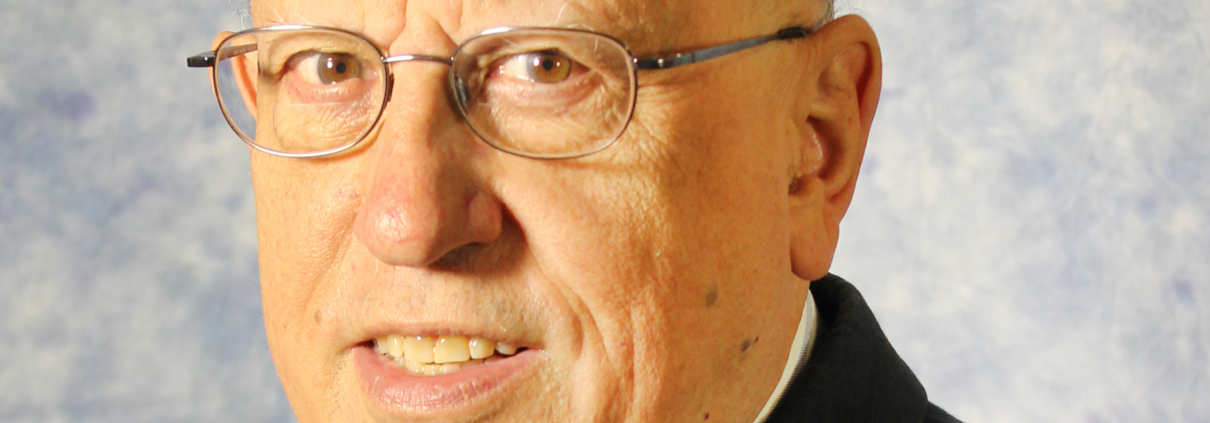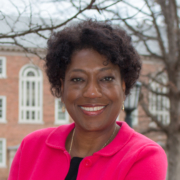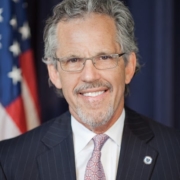Laws that mandate education for special needs students have not always existed. In the United States, courts only began referring to students with special needs in the early 1900s. At the time, such students were typically excluded from public school.
Things began to change after the Brown v. Board of Education supreme country ruling in 1954. Twenty years later in the 1970s, Congress enacted various legislation mandating educational services and support for children with special needs.
My guest today is Charlie Russo. In our conversation, Charlie details the power of the Individuals with Disabilities Education Act and situates it in an international context.
Charlie Russo is the Joseph Panzer Chair in Education in the School of Education and Health Sciences and Research Professor of Law in the School of Law at the University of Dayton.
Citation: Russo, Charlie, interview with Will Brehm, FreshEd, 155, podcast audio, May 6, 2019. https://www.freshedpodcast.com/charlesrusso/
Transcript, translation, and resources:
Will Brehm 1:57
Charlie Russo, welcome to FreshEd.
Charlie Russo 1:59
Thank you.
Will Brehm 2:00
So how many children in the USA receive special education services?
Charlie Russo 2:05
As you may know kids in the United States are covered between the ages of 3 and 21, or students are covered between the ages of 3 and 21. Before the age of 3, kids can be served, but not mandated that these federal services. Students age out at 21. At 18 or so when they graduate high school or 21, whichever comes later. So, I looked just earlier today, according to the US statistics for 2017/18, which is the most recent data available, a precise number of kids age 3 to 21 is 6,904,332 public school students are served. And that’s out of a total of about 55 million students in the United States.
Will Brehm 2:46
So, what would that percentage be?
Charlie Russo 2:48
A little bit around 10%? I think 10. Six would be 10%.
Will Brehm 2:52
Yeah right.
Charlie Russo 2:53
So, and I’ve heard numbers as high as 13, and 14 and it just depends on how states count things and that sort of thing. The US Department of Education had a breakdown by 3 to 5, 5 to 12, and so on and so on. So, I just took the broadest. So, it would be 6,900,000 all kids served in the United States not just public-school kids.
Will Brehm 3:13
Right. So, 6 million or so students between the ages of 3 and 21 are considered or are receiving special education services. And what are some of the services that they would receive?
Charlie Russo 3:27
When a child qualifies for special education or before in the process of qualifying. Under the IDEA, in order to be entitled to services, kids need to meet four criteria: 1) be between the ages of 3 and 21; 2) have a specific disability such as autism, learning disability, visual impairments, audio impairments; 3) need related services. Related services are those things that make it easier for a child to get through school. And reading part of the statute includes such things as transportation, speech language pathology, audiology services, interpreting services, psychological services, physical and occupational therapy, recreation therapy, social work services, and school nurse services. So, it’s pretty much a “one stop fits all” in a certain sense in making sure that a child can remain in school.
Will Brehm 4:20
Right. I mean, it sounds like that related services is such a broad category that it can include almost anything.
Charlie Russo 4:27
And there’s some litigation going back to the mid 80’s. It also includes residential placements. And I don’t want to sound utilitarian or deny anybody services. But residential placements can cost easily in the hundreds of thousands to a million dollars a year.
Will Brehm 4:41
What is a residential placement?
Charlie Russo 4:43
There’s a case of I think, 1988, if I get the date, right, Timothy W. Timothy was born, barely able to hear or speak or respond to anything, and he could not be served certainly in a home setting or in a school setting. So, he was basically in a medical facility. And the school board in New Hampshire challenged having to pay for all of Timothy’s placement. About 5% of the cost was educational. About 95% was medical and the board simply said, Look, we’ll pay the educational part but because so much is medical, and he is not capable of learning in a certain sense beyond some very basic ideas -and I’m not trying to minimize who he was- I never knew, for example, he had to learn to swallow. I always thought swallowing was a reflex action. But back then, and this is, you know, 30 something years ago, it was over $500,000 a year, and now they’ll be up over a million dollars in some places. And again, I don’t want to say he shouldn’t be served. The question rather, is because IDEA is a federal mandate, can or should the federal government do more, to help states meet this financial cost because the money comes out of the same budget. And I don’t want to get into an argument of robbing Peter to pay Paul, and you want to serve all kids but because his needs are so great, it does place a financial strain on school boards and the federal government has not been forthcoming. As I said to my students, I’m just finishing up a class in the law school and I cover some special ed in that class. I said, you know, in two years or so, when we’re having a presidential election, I don’t think too many people are going to be running about their placement or what their standard is on special education. I think it should be a greater priority than it is but that’s just the reality. So, it’s been a very good statute. I know you didn’t ask but I edited a book some years ago, I can’t remember 7, 8, 10 years ago, where I was able to get 21 different nations, 21 different authors from around the world -and I say this not because I’m American but I think I could fairly take a step back and say the IDEA, the Individuals with Disabilities Education Act, is by far the most comprehensive disability law in the world for students according to a UNESCO report that I footnoted, and I’ll be honest, I haven’t looked up to check how current it was. At that point only about 45 nations in the world even had laws addressing the needs of educating kids with disabilities. That said, it’s a little bit beyond where we are maybe, but Great Britain has a very good law. Canada’s got a good law. Australia’s is catching up. New Zealand is not quite where they think they are, but they’re trying to catch up so there’s a great deal of litigation and there’s a great deal of conflict over exactly what kids needs are. So, with that being said, while it’s a very good law, even a good law could be made better.
Will Brehm 7:24
Right. And what’s interesting is that it is this federally mandated law. It has these sort of very large categories, like related services. And so, in a sense, it does become very comprehensive. But I guess one of the questions I have is: Has it always been that way? How were special needs children and students served by public schools historically in America?
Charlie Russo 7:47
Not real well to be honest with you. I’ve got two books, three books out with a friend of mine, Alan Osborne, who is also involved in education law. And Alan is much more knowledgeable than I am. I defer to Alan. But in research in that book, we found the earliest case apparently was from Massachusetts in 1893. It upheld the students being excluded from school for being quote, “weak-minded.” And in 1919, I’m going to read you this, the Supreme Court of Wisconsin ruled that a child with disabilities who spoke hesitatingly and drooled uncontrollably, even though he had academic ability to learn could be excluded from school, quote, “because his physical condition and ailment produced a depressing and nauseating effect upon the teachers and school children.” So, 1919, 100 years ago.
Will Brehm 8:36
So, 100 years ago children with disabilities were simply excluded from public school?
Charlie Russo 8:43
With the exception of a few programs in large cities like New York, Chicago and Philadelphia, absolutely. But it doesn’t get much better. The IDEA, as I think we’ll talk later, perhaps, was initially enacted in 1975. And then a congressional report, dated July 1, 1974,and I’m sorry to read some statistics to you: The Congress reported that 78.5% of the more than 8 million children receiving needing special ed services received some services. If you do the math, that means that about 21.5% receive nothing. Of those – and again, it just “lies, damn lies, and statistics” – 47.8%, less than half of the total number receive what we would today consider special education related services. That’s 47.8% of kids as of July 1, 1974, the year before IDEA came out, 47.8% of kids received what today would be considered an acceptable IEP, that they’re making progress towards goals. Another 30.7% received some special education instruction but no related services. And another 21% did not receive any educational services whatsoever. Many of those kids stayed at home, kind of catches-catch-can and whatever would happen.
I first started my higher ed career teaching at Fordham University in midtown Manhattan. And a couple of summers ago when I was talking about special education -in a class were people from faith-based schools- I threw out a line, most of the people looked at me like I was strange. Well, although I went to Catholic school growing up as a kid, I remembered what New York City called 600 schools -600, 601 and so on- and those were special ed schools. They were segregated to special needs kids. And I didn’t really meet too many people who taught in them -it’s been a while before my career. But from what I’ve read from the little bit, I’ve spoken with people. And I don’t like this expression, but I can’t think of something better. So, my apologies. Kids were essentially warehoused -they received minimal services. They tried to provide them with some elements of instruction but on average, again, from what I’ve read, not approaching anything that kids would have received today.
Will Brehm 11:05
Right, and I mean, did it take from the early 1900s until 1975 for that to change? Did it take nearly 75 years?
Charlie Russo 11:15
It kind of did in stages. In the late teens, I think it was NYU, came up with the first degree in what we would call special education today. And right up until 1929 again, some large cities had some pretty good programs -New York, Chicago. Prior to 1975 kids with disabilities were described as educable or trainable, not as having intellectual disabilities. And I think that’s a condescending term. I don’t think it was quite meant that way. But I wanted to leave it in to show how using the right word sends a message about what’s going on. So, until 1929, some programs did pretty well. When the Depression hit the bottom, fell out. And then -I grew up in Brooklyn, and I can remember being 7, 8, 9 years old, and I don’t remember how young I was- my mom volunteered at the local Veterans Hospital for soldiers who had been injured in World War Two. You know, we’re only talking 10 years since the end of World War Two. And so, services were beginning to improve but they were nowhere where they were today. And they were mostly kind of vocational rehabilitation for soldiers and military personnel who were injured. In 1954, Brown versus Board of Education, which I think it’s safe to say is the most important, substantive decision of the United States Supreme Court of all time. If somebody wanted to quibble, I think one might be able to say that Madison v. Marbury wherein the court gave itself the jurisdiction to hear disputes might be more important because without that you wouldn’t have ground. But I’ve been fortunate, over the last 20 or so years, to get very much involved in the small but growing international community doing with education law, and Brown is well known outside of the United States. For example, in 2004, I was able to organize a conference with help, certainly from South African friends. We did another one in 2014. I don’t remember the year frankly, but I helped organize a conference in Amsterdam where Brown was central. Maybe not in the theme. And sometimes people challenge me, not without some reason but I still think it’s fair to say that Brown ushered in an era of equal educational opportunity. I often ask questions in my class, both online and in-person -online is a different dynamic when you’re reading answers- in light of Brown’s promise of equal educational opportunity, I’ll ask: what grade would you give the US? A,B,C,D,F? You know, most people and I probably fall in there with a C-plus, B range. We’ve made some progress but we’re not there yet. You know, we still have a long way to go. But if Brown did not happen when it did, most people in educational I think it’s fair to say, would agree with me, that Title IX would not have been enacted in 1972, and it was to ensure rights for women. Section 504 would not have been adopted in 1973. And the IDEA would not have come in 1975. But Brown is certainly recognized as a catalyst, certainly in education, but in so many other areas of American culture from housing, to employment, to almost anything you could possibly think of. So, Brown was the impetus but again, as good as the IDEA is and as hard as our system tries, we’re not there yet.
Will Brehm 14:26
So, what would you change? I mean, so you know, the IDEA actually has gone through multiple sort of revisions, or I’m not really sure they’re the correct word, they overhauled it sometimes over the years. So, what would you want to see the IDEA include that it doesn’t currently include?
Charlie Russo 14:44
Good question. And they’re all good questions. The IDEA -to back up a second- was last reauthorized in 2004. That’s the longest since its first adoption in 1975. And, frankly, I think Congress has kind of given up in a certain regard into schools. I teach in a school of education where the issues are a little bit different from students as they are from a law school. But having pretty regular contact with prospective and practicing school administrators from assistant principals up to superintendents in our Ph.D. program, I think a major concern with the IDEA is something we alluded to a little bit earlier ‘funding’. It’s got some great programs but they’re extremely expensive, money for education is tight. And unfortunately, I think it becomes robbing Peter to pay Paul. And again, I quickly add that I don’t want to be utilitarian by excluding one group over another, but the fact of the matter is, some of the services are extremely expensive, and those kids have a right to get them. But when they come out of the budget, that’s kind of taken from the other side of the budget so those kids get a little bit less. So, I think that’s one thing I’d like to do is get the funding up there.
I used to teach at the University of Kentucky where I was much more involved with the Commonwealth or state level. I have not been involved in Ohio quite so much, I do some other things. And I really think that counseling services should be available to parents. Parents fall into, of course, a lot of different categories. But on the one hand, you get the upper-middle income family that has the brand-new BMW and the baby seat in the back, and they want the perfect child and that sort of thing. And they get a child in terms of the IDEA has needs. So, I think they struggle, and are often resentful even, that they have a child with disability. At the other end, and I was kind of taken aback -I moved from New York City to University of Kentucky in 1992. And I grew up in a bit of a bubble on. In Brooklyn and Queens, it’s different. We lived in Nassau County, where there was poverty for sure, but I didn’t live around the poverty in that sense. But when I moved to Kentucky, a number of students told me what I hear from people in Ohio now that many parents of children with special needs don’t really understand the process perhaps as well as they need to. So, I think the schools need to try to do a better job to educate parents to help schools help their kids. How you would do that I’m not entirely sure. To make a long story short, when I was at Fordham, I did some work in the South Bronx. And the program in short was to trying to teach mothers to help their kids with their reading homework. New York City in this program paid parents in 1991 I think it was, the pretty decent sum of $25 an hour to come to a to a session. About a third of the parents came and they were all women, not one man came. And I don’t know whether because they were embarrassed about their own language skills, or they just didn’t care or, you know, all the above so to speak. I think we need to get parents more actively involved in understanding what their kids have done by reaching out. The statute itself includes substantive and procedural due process protections that regular kids don’t get. And I talk about this in class usually, is that parents can bring a due process hearing almost anytime they want. They can force the school board to bring in a third-party independent decision maker. And because that process gets expensive. I’ve heard from many school administrators -again, hearsay, but I’ve heard it from enough people over enough time- in fact, that when parents ask for due process and given the cost, they tend to buckle, okay, what can we do to make it go away? And the thing that concerns me about that, as you can imagine, is what I call the squeaky wheel theory: the parents who need the least help are the ones coming in for the most. And the people at the bottom-end who really are kind of lost, get lost in the shuffle, because they’re not questioning.
Will Brehm 18:19
What can be done about that?
Charlie Russo 18:21
That’s the rub. I hate to say it’s above my pay grade but one of the things that I’m a big believer in is professional development for educators. I taught secondary school. That’s 30 years since I last left high school and it was a Catholic school, in fairness, so we didn’t have special needs kids, except for a couple of 504 kids. But I’m told that in many, many high schools, especially the high school teachers just don’t want to be -“leave me alone, I don’t want the special ed kids. So, I think we got to get the teachers to become a stronger part of the team and then also do something to bring the parents in and help them to better understand. We have a booklet it’s online now. I guess you’d have to print it out. It’s called, “Whose IDEA is it?” And in the past, I’ve used it as a supplemental textbook to a graduate school law course focusing on special education law. I would think the average parent who did not go to college, even the average person who went to college, would have an awfully hard time reading that jargon. So, and I’ve heard students say the same thing, you know, we think we’re helping parents, they go home and read this and it’s like reading another language for parents. I had a friend in Kentucky, who was an engineer and if you couldn’t quantify something to four points after the decimal point, you couldn’t quite handle it. And there’s a lot of those kinds of grey decisions. So even parents who are well-educated, through no fault of their own and no lack of interest, are running up against the system that’s really pretty different from what they’re used to doing. And much more complicated than I think, than they anticipated. And I got to believe that if you get parental involvement, it’s going to have to help the system. But the trick is how to get parents to do that. When I was a high school teacher, frankly, I hated going in for report card nights. Because 90% of the parents, are “Oh, Mr. Bonn I’m glad to have your son in my class, he’s a wonderful kid”, you know, and those are the parents who came in. The kids who was C and D students, you never saw their parents and I think there was a correlation there. So, how do we get the parents who most need to be there? Well, if I knew the answer to that I’d be Secretary of Education or something.
Will Brehm 20:32
So, one of the issues that fascinates me about the IDEA is that, you know, it does cover children from age 3 to age 21. And I always wonder what happens to students with special needs after the schooling ends? Like is there a transition to other parts of life outside of school?
Charlie Russo 20:57
Sure. Another good question. The IDEA requires that at age 16, if not a little bit sooner, some kids have disabilities that allow them to function a little bit more highly than others. So, for a kid who’s let’s say a slight learning disability or a mild learning disability, transition may begin at 15 if that kid looks like she or he is going to be on track to graduate at 18, or so. So, no later than 16, schools are obligated to develop with parents, with the kids if the kids are capable of doing so, a so-called transition plan that helps smooth the transition to post-secondary school life. And sometimes that’s to work in a sheltered workshop. One of my daughter’s close friends, in fact, it was her maid of honor, I think -her brother was down syndrome and they attended a Roman Catholic school, but the school had program for kids until 21. They received some help from the city of Dayton. And I know they helped him transition from personal experience. He goes to work every day on a bus to a sheltered workshop. Some other kids – well back it up. I had a student defend a dissertation a year ago, year and a half ago, I can’t remember. He talked about students on college campuses with emotional disabilities. This recent student of mine, who’s a school psychologist studied university students with emotional-type disabilities, who did not seek help, mostly because they feared they would be identified and kind of shunned on campus as, you know, crazies or loons or something like that -again, improper language but that’s some of the language that many of the students used in referring to themselves. They didn’t want to be thought of, as you know, not a regular person. So, they will have had a transition plan to help them deal with that when it comes to university now. And part of the response is that once a student graduates or turns 21. And 21 has been interpreted as the day before you turn 22. IDEA services expire; however, a student may well be entitled to receive services under Section 504 of the Rehabilitation Act. So probably just about everyone, I’ve never seen a statistic. But I don’t doubt that there every place builders to provide them with transition services to make their way around campus. The downside of that, if there is one, is that under the IDEA it’s the obligation of states, through local school boards and their personnel to identify, assess and serve students in need. Under 504, the obligation is on the person of need to come up and ask for help. Nothing prevents me from asking you whether you need help. But if you have an emotional disability, you just sit there a class and it doesn’t come out. I may not know enough to ask whether you need help. It’s one thing if a student is coming into class and falls and breaks his leg and for the next three weeks, he’s got his ankle in a cast, right? I could ask, “Do you need a chair to prop your leg”? An emotional difficulty, I can’t tell that without more. And many university students according to this one study, but he did a review of literature that said, you know the same kind of thing happens. Kids get to college, and they’re afraid being ostracized. So, they’re not taking advantage of services that can help them be that much more successful. And I hope that makes sense that I’m not just rambling, I see some connection in there.
Will Brehm 24:28
So, one of the things that fascinates me as well is that the US is not a signatory of the UN Convention of the Rights of the Child. And it’s one of just a few countries in the whole world that has not signed on to this convention. Do you think that if America did sign on to that convention, that the protection of children with disabilities would change in America? Like would this international convention actually improve the way in which children with special needs are treated in America?
Charlie Russo 25:02
Good question. I am probably one of the most internationally-minded people in the US education law community. And when I go to Europe, I often get that as a kind of question. In Australia, I don’t get it so much. In South Africa, frankly, they’ve got some other issues to get dealt with first. And in 2005, in a case involving the death penalty, which is not relevant, except that Justice Kennedy pointed out that the US and Somalia were the only two countries that had not signed on and I read someplace that now says only the US did not sign on. If you go back and read the history of the Senate, and it was under Bill Clinton. People always say, you know, it was Reagan, or it was Bush or something. Bill Clinton was president, so it was a democrat administration, which I think was supportive. Around 2005 or so. Or after the bill was introduced, a number of Southern senators were concerned that if the United States had signed on to the document, to the Rights of the Child, it would give up a certain amount of American sovereignty. There were even a couple of comments, because I looked at the legislative history, that they were afraid that if somebody or if a state used corporal punishment, would be at risk for international sanctions. And when I’m in Europe, in particular, if my friends over there, push a little too hard, the answer I usually give them is that I think it would have been nice if the US signed but in fairness, I don’t think anybody can argue that kids with disabilities have been denied services because we did not sign on to the doc. Again, I’ve written a number of articles about some of the documents. I think there’s some good language in there. But there’s language in there about giving kids greatest say over the control of their education. Under IDEA, as you may know, as a kid turns 18, they have the right to control their educational records. There’s a battle, not just in Europe, a little bit in the States, but more in Europe, I would say, does a child have to say automatically at 13? Certainly, as kids get a little bit older, they ought to have some say in determining their placements and what they’re going to study, and so on and so on. But one of the things about the Convention on the Rights of the Child and many international documents -there’s lovely platitudes, they sound great on paper, but do they really get effectuated? And you know, I don’t want to get political and name this country and that country and other countries and say what are they doing? Because that doesn’t address the issue. I think we give a pretty good level of services. It might be nice to join an international community for the sake of solidarity but realistically, I don’t think that would impact the level of services that kids would receive if we had signed on to that docket.
Will Brehm 27:44
Interesting. Well, Charlie Russo, thank you so much for joining FreshEd. Really fascinating to talk and I do hope that the Congress reauthorizes the IDEA and puts more funding behind it.
Charlie Russo 27:55
Thank so the opportunity. I hope so too. But one gratuitous bit of advice, don’t hold your breath waiting for Congress to act. Thanks very much, nice talking.
Special Education Law in the United States and Beyond










